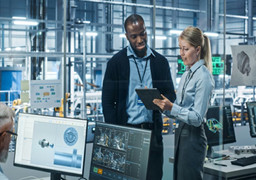
|
물리적 ‘경제’와 ‘일’의 종말에 대해 | |||
| 디지털 경제로 인해, 메타버스를 비롯해 완전히 가상적인 것들(virtua... |


  |
 |  |
 |
물리적 ‘경제’와 ‘일’의 종말에 대해
디지털 경제로 인해, 메타버스를 비롯해 완전히 가상적인 것들(virtual things)만 앞으로 더욱 중요해질 것이라는 인식이 퍼져있다. 이러한 인식에서 물리적인 것들은 그 다음으로 중요한 주제가 되고 있다. 하지만 2020년대를 바라볼 때, 실제 증거는 우리에게 무엇을 말하고 있는가?
지난 수십 년에 걸쳐 미국을 비롯한 선진 경제국가들은 제조업으로 대변되는, 즉, 물리적 솔루션을 제공하는 산업에서 효과적으로 경쟁하는 데 필요한 물적, 지적, 인적 자본을 간과하는 정책을 펴왔다. 왜 그러했을까? 1990년대가 시작되면서, 완전히 가상의 것들(virtual things)이 정말 중요하게 여겨지는 세상이 될 것이라는 인식이 널리 퍼졌기 때문이다. 이는 디지털 테크노 경제 혁명으로 인해 일어난 것인데, 이러한 인식에서 물리적인 것들은 그 다음으로 중요한 주제가 되었다.
이러한 인식의 전제는 그러한 물리적 활동은 ‘어느 장소든 어느 누구든지’에 의해서도 수행될 수 있다는 것이었다. 즉, 물리적 제품들이 어딘가의 누구를 통해 완성된 제품으로 생산되어, 미국의 기업과 가정에서 필요로 하는 시간과 장소에 정확하게 마술처럼 나타날 것이라 믿었던 것이다.
반도체만 해도 그렇다. 한 때 미국은 반도체를 설계하고 생산하는 세계 최고의 국가였지만, 어느 때부터인지 원천 기술 개발과 지적 재산권 확보에만 집중하고, 물리적 생산은 미국 밖의 국가에 의탁하는 상황이 되었다. 대만의 TSMC와 삼성전자의 반도체 산업 도약은, 바로 이러한 미국의 믿음과 인식 하에 이뤄진 것이다.
미국은 이렇게 기술을 중심으로 경제를 구성했을 때, 전 세계적으로 생산성 향상과 수요 충족이 발생하여 자국 내 잉여 노동력이 크게 증가할 것으로 인식했다. 이러한 믿음과 전제 하에서, 21세기에 나타날 ‘물리적인 일의 종말’에 대한 기대는 놀라운 일이 아니었다.
하지만 경제학자 알렉산더 필드(Alexander Field)가 그의 저서 ‘위대한 도약, 1930년대 경기침체와 미국의 경제 성장(A Great Leap Forward: 1930s Depression and U.S. Economic Growth)’에서 명확하게 기술한 바와 같이, 1929년까지 미국의 생산성은 1919년 대비 3분의 2만큼 상승했는데, 그 원인은 세 가지 트렌드들의 융합이었다.
1) 산업을 전기로 움직이게 하는, 즉 전화(전화)를 가능하게 한 기계
2) 기본 생산 공정에 대한 지식의 발전
3) 현대 화학의 도래와 함께 새로운 재료의 출현
1920년대 이 세 가지 아날로그 트렌드들의 융합이 거대한 생산성 향상과 경제 성장을 이끌었던 것이다. 2020년대 디지털 트렌드들의 융합도 이와 유사한 바가 있다. 따라서 이를 이해하는 것이 중요하다. 2020년데 세 가지 트렌드들은 다음과 같다.
1) 실질적으로 무제한적 규모로 정보에 접근하고 조작할 수 있도록 하는 기계
2) 거의 ‘모든 것’에 대한 세분화된 실시간 정보의 축적
3) 새로운 나노기술과 생명공학에 대한 이해
각종 경제 차트를 보면 알 수 있듯, 생산성 증가의 썰물과 흐름은 일정하지도 않고 선형도 아니다. 우리가 1920년대에 본 엄청난 생산성 급증은 1960년대와 닷컴 시대에도 다시 나타났다. 한편, 1930년대의 엄청난 생산성 하락은 카터와 오바마의 시대에도 그대로 재현되었다. 메시지는 분명하다. 우리는 혁신에 있어 기복을 겪는다는 것, 그리고 혁신은 생산성 성장에 있어 역시 기복을 이끈다는 것이다.
더 중요한 것은 이러한 상승 혹은 성장은 기계, 재료, 지식과 관련한 보완적인 추세가 나타날 때 일어난다는 것이다. 따라서 이러한 세 가지 트렌드들의 융합은 1920년대와 마찬가지로 오늘날 향후 10년을 특별한 기회의 시기로 만드는 데 매우 중요한 것들이다.
기술 분야의 미래학자로 큰 존경을 받고 있는 마크 밀즈(Mark Mills)는 그의 가장 최근 저서인 ‘클라우드 혁명(The Clous Revolution)’에서 이러한 트렌드들과 기타 다른 요소들의 관계를 검토했다.
밀즈에 따르면, 많은 사람들은 인공지능의 가속화로 공장 노동자에서 패스트푸드 직원에 이르기까지 수많은 직업들이 영구적으로 없어질 것으로 우려한다. 그래서 경제학자들은 자동화, 로봇, 특히 인공지능이 경제의 많은 부문에서 ‘물리적인 일의 종말’을 예고하고, 이로 인한 높은 실업 수준을 대비하여 사회가 영구적으로 실업 상태에 있게 될 사람들을 위한 ‘보편적 기본 소득’을 마련해야 한다고 요구한다. 하지만 밀즈는 이러한 방식은 새로운 주장도 새로운 해결책도 아니라고 말한다.
사실 인간의 노동을 기계가 대신할 것이라는 두려움은 산업 자동화가 급속히 확대되면서, 사회가 대량 생산 시대로 접어들던 1930년대에 최고조로 달아올랐다. 1930년대 GDP와 생산성 침체가 지속되지 않았음에도, 이렇게 기술이 주도하는 실업에 대한 두려움은 지속되었던 것이다. 그리고 자동화에 대한 불안은 1960년대에 다시 나타났다.
하지만 결론은 기술이 고용을 위협하지는 않는다는 것이다. 왕 연구소(Wang Laboratories)가 최초의 실용적인 워드 프로세서를 개발한 1976년을 보자. 처음에는 독립형 기계로, 이후에는 PC에 흡수된 워드 프로세싱은 당시 대부분 여성이 담당했던 대부분의 비서 업무뿐만 아니라 오래된 기업의 ‘타이핑 인력’을 빠르게 대체했다. 이 사무용 노동 절약 기술은 노동력에 진입하는 여성의 수가 크게 증가하는 시기에 등장했다. 그러나 당시 데이터에서 알 수 있듯, 일반 실업률이나 여성 실업률은 치솟지 않았다.
스프레드시트와 컴퓨터 그래픽 프로그램이 도입된 후에도 동일한 패턴이 나타났다. 이 기술로 인해 계산 작업과 제도 작업이 없어졌다. 1980년대와 1990년대의 이와 유사한 많은 기술들이 발전했지만, 그러한 새로운 노동 절약 도구들은 미국의 전반적인 고용 성장과 궤를 같이 했다.
밀즈는 피할 수 없는 일시적인 경기 침체는 항시 존재하지만, 이것을 노동 절약 기술에게 묻는 것은 아주 오래 전에 시작된 잘못된 전통이라고 말한다. 결론적으로 19세기 후반 이후 일어난 지속적인 기술 변화는 ‘노동력 절감’을 통해 생산성을 크게 향상시켰고, 이는 결과적으로 미국의 1인당 실질 자산을 10배 가까이 올릴 정도로 전체적인 경제를 향상시켰다. 또한 모든 ‘노동력 절감’ 기술에도 불구하고, 평균적으로 의지와 능력이 있는 사람들의 약 95%는 전체 150년 동안 계속 고용을 유지했다는 것이다.
물론 주기적인 경기 침체로 인해 고용률에 일시적 변동이 있었던 것은 사실이지만, 그것은 일시적인 현상이었다.
노동력 절감 기술이 일자리를 없애는 역할을 했다면 실업률은 그 모든 역사를 통틀어 지속적으로 상승했어야 했다. 하지만 현실은 그렇지 않았다. MIT 경제학자 데이비드 오토(David Autor)는 노동력 절감 기술의 거침없는 발전에도 불구하고 고용이 계속 증가한다는 명백한 역설에 대해 언급하며, 고용 성장 전망과 관련한 근본적 위협은 기술 자체가 아니라 정부의 경영 능력 부실에 있다고 말한바 있다.
결론은 오늘날 디지털 트렌드들의 융합이 새로운 일자리, 그것도 물리적인 일의 영역을 계속 창출한다는 것이다.
역사적으로 사람들이 고용되는 장소와 방식은 시간이 지남에 따라 농업에서 제조업으로, 다시 서비스업으로 이동하며 변화해왔다. 그래서인지 사람들은 이제 인공지능과 로봇 공학 기술이 과거 산업 기술이 농업에 가했던 것과 같은 일을 서비스 및 제조 산업에도 가할 것이라고 믿는다. 하지만 이 비교는 잘못된 것이다.
‘제조품’의 소비는 ‘식품’ 소비와 동일한 물리적 한계에 제약을 받지 않기 때문이다. 성숙한 경제에서 식량 수요와 식량 생산은 인구 증가와 함께 대략적으로 증가해왔다. 적절한 식량이 부족한 신흥 국가나 시장에서는 수요 증가에 대한 상당한 잠재력이 아직도 여전히 존재할 것이다. 그러나 이것도 부유한 식단과 최소한의 적정 식단 사이에는 1인당 칼로리 섭취량에 있어 약 2배의 차이만 존재할 뿐이다. 부유하고 풍족한 사회라고 해서 10배 이상 더 많은 식량소비가 발생하지는 않는 이치다.
반면 제조품은 다르다. 제조품에 대한 수요는 인구가 증가하는 것보다 훨씬 더 빠르게 늘어난다. 소득이 증가함에 따라 사람들은 편안하고 편리하고 삶의 질을 높여주는 제품을 더 많이 구매할 것이다. 그리고 혁신가들은 새로운 혁신 제품을 계속적으로 발명함으로써 끊임없이 새로운 수요를 창출한다.
식품과 가공품 사이의 이러한 핵심적 차이는 데이터에서도 명확하게 볼 수 있다. 농업 소비는 미국에서 지난 반세기 동안 인구 증가와 밀접하게 성장해왔는데, 둘 모두 약 80% 수준의 성장을 보였다. 그렇다면 ‘제조품’은 어떨까? 이 기간 제조품의 소비는 약 300% 증가했다!
아직 상용화되지 않았거나 발명되지 않은 수많은 제품을 고려하지 않더라도 이러한 제조품에 대한 글로벌 수요는 급격한 성장이 가능하다. 에어컨, 자동차, 컴퓨터, 가전 제품, 기타 소위 ‘사치품’과 같은 삶을 변화시키는 품목의 경우 제조 비용이 떨어지면서 이 성장은 특히 더 도드라질 것이다.
대부분의 경우 이러한 잠재 수요는 현재 수준의 10∼100배이다. 예를 들어, 미국에서는 인구의 거의 90%가 에이컨이나 자동차를 보유하고 있다. 그러나 수십억 명의 사람들은 이러한 제조품의 소유가 인구의 10% 이하인 국가에서 살고 있다.
이는 물리적 제품에 대한 수요가 곧 종말을 고할 것이라는 주장은 크게 과장된 것이 분명하다. 분명히, 기술이 제품에 더 큰 능력을 부여하고 제조비를 상당히 낮추면서, 기존 제품과 신제품에 대한 미개척 수요는 더욱 크게 증가할 것이다.
또한 소위 가상 경제의 기하급수적인 성장을 지원하는 데 필요한 인프라도 이를 실행하는 데 막대한 양의 물리적인 하드웨어와 기가와트의 전력을 필요로 한다. 다만 이는 눈으로 잘 보이지 않을 따름이다. 즉, 제조업체 또는 유틸리티가 순수 연구에서 설계, 데이터 센터, 공급망 관리, 계약 제조의 특정 요소에 대한 마케팅 지원에 이르기까지 다양한 것들이 아웃소싱되면서, 직업과 경제 활동이 제조가 아닌 ‘비즈니스 서비스’ 형태로 나타나기 때문이다.
이는 제조업이 실제보다 더 빨리 줄어들고 있다는 잘못된 인상을 준다. 그러나 그것이 전부는 아니다. 미국을 비롯한 선진 경제 국가들은 실제로 대만, 독일, 한국, 일본에 주로 위치한 해외 공급업체에 첨단 제조 능력을 양도하고 있을 뿐이다. 따라서 인공지능과 로봇 공학 시대에 급증하는 생산성과 하락하는 제품 비용은 더 많은 물리적 일로 이어질 것이다. 문제는 이렇게 많아진 물리적 일을 사람들이 할 것인지 안 할 것인지 여부에 있다. 미국 또한 마찬가지다.
특히 코로나 팬데믹은 이러한 기존의 가상 세계, 물리적 일의 종말에 대해 재고를 하게 했다. 전 세계의 정책 입안자들은 필수 산업, 특히 그 중에서도 특히 의료와 관련된 일자리 및 공급망을 리쇼어링하는 데 다시 집중하고 있다. 그러나 전체적인 제조업 자체를 활성화하는 것과 관련하여 자동화 및 정보 기술이 그 일자리를 차지할 것이기 때문에 이것이 고용에서 상당한 이익으로 이어지지는 않을 것으로 보는 것 같다.
이에 이들은 최근 수십 년 동안 경제에서 제조업 고용이 감소하는 추세가 계속될 것이라 전망하고 있다. 그러나 데이터는 이러한 전망을 뒷받침하지 않는다. 예를 들어 2010년부터 코로나 셧다운 직전까지 미국 제조업 부문에서는 고용과 생산량이 실제로 증가했다.
또한 가상 경제를 가능하게 하는 데는 엄청난 양의 물리적 자원이 계속 필요하고 더 크게 성장하고 있다. 여기에는 전례 없는 대역폭으로 점점 더 기능이 향상되는 수백억 개의 장치에 연결된 상상할 수 없을 정도로 큰 데이터 센터 네트워크가 포함된다.
이러한 추세를 감안할 때 우리는 다음과 같은 예측을 내려 본다.
첫째, 지금부터 2032년까지 정보 기술의 가격 대비 성능이 1000배 향상되어 삶의 질을 획기적으로 향상시킬 것이다.
또한 이것은 낮은 가격이지만 기능은 훨씬 더 커지는 것으로 이어질 것이다. 저렴하고 강력한 기술은 더 많은 사람들이 더 많은 장소에서 이 기술을 사용할 수 있게 할 것이고, 한때 불가능하다고 생각되었던 애플리케이션도 보편화되고 유비쿼터스될 것이다.
둘째, 클라우드 기반의 폭발적 증가는 정보 인프라에 대한 지속적인 투자를 필요로 할 것이다.
미국 기업들은 이미 ‘정보 인프라’에 연간 약 1조 달러를 지출하고 있으며 이러한 속도가 향후 10년 동안 가속화될 것으로 볼 수 있는 충분한 근거가 있다. 정보 인프라에는 기지국, 데이터 센터, 광섬유 네트워크, 위성 및 기타 많은 것들이 포함된다. 그리고 이 모든 것이 원자재 추출, 제조 공정, 물류 지원 및 설치를 필요로 하는 물리적 실체임을 인식해야 한다. 이는 더 많은 사람들이 고용됨을 의미한다.
셋째, 인공지능과 로봇의 도움으로 새롭고 유용한 분자 구조의 수와 다양성이 폭발적 속도로 증가하면서, 새로운 제품과 서비스 기회가 열릴 것이다.
과거에 비해 오늘날의 연구자들이 사용할 수 있는 물질의 누적 수는 3배 이상 증가했다. 차세대 솔루션을 효율적으로 생성하기 위한 경로로 분자가 재활용되고 있다. 자동화된 화학 설계, 합성, 테스트는 점점 더 비용 효율적이 되고 있다. 암과 치매 치료제든, 하늘을 나는 자동차든, 화학의 최전선을 발전시키는 저가 우주선의 잠재력이든 그 결과는 새로운 기업의 탄생과 인류의 더 나은 삶이 될 것이다.
넷째, 인공지능과 로봇 공학으로 인해 생산성이 급증하고 제품 비용이 하락하면 작업량이 줄어들기보다는 더 많아질 것이다.
여기에는 클라우드 지원 장치의 생산과 정보 인프라 구축이 포함된다. 이미 지구에는 1인당 대략 4개의 인터넷 연결 장치가 존재하고 이는 이제 시작에 불과하다. 아직 상용화되지 않았거나 발명되지 않은 수많은 제품을 고려하면 수요 잠재력은 가늠할 수 없이 크고, 이에 따른 작업량은 더욱 늘어날 것이다. 물리적 경제는 여전히 우리에게 중요할 것이다.
다섯째, 올바른 정책을 통해, 더 많은 사람들이 물리적 경제를 통해 더 많은 보상을 받을 것이다.
코로나 팬데믹과 우크라이나 침공을 통해 사람들은 물리적인 것이 여전히 매우 중요하다는 것을 깨닫게 되었다. 그것은 물건을 디자인하고 서로에게 서비스를 제공하는 것만으로는 이제 충분하지 않다는 것을 의미한다. 다른 국가, 다른 국가 사람들이 제품을 만들고, 그 제품들이 우리 앞에 마법처럼 나타날 것이라는 가정은 서서히 무너지고 있다. 이제 이러한 공급망 대신, 위험을 최소화하고, 비용을 줄이며, 유연성을 높이고 효율성을 높이기 위해 물리적 제조가 재편되고 재통합될 것이다. 다만 이러한 공급망을 대체하는 새로운 물리적 환경에서 일할 사람이 부족한 점이 정책 입안자들의 큰 고민거리가 될 것이다.
Resource:
1. AEIdeas. June 7, 2022. Bret Swanson. Robots and Good Jobs on the Other Side of “COVID-flation.”
2. AEIdeas. February 12, 2022. Bret Swanson. Hard Industries, Hard Work, and Big Opportunities.
3. Encounter Books. November 2, 2021. Mark Mills. The Cloud Revolution: How the Convergence of New Technologies Will Unleash the Next Economic Boom and A Roaring 2020s.
4. AEIdeas. November 29, 2021. Bret Swanson. How the Cloud Powers Moore’s Law, and More.
5. RealClearPoilicy.com. January 07, 2022. Bronwyn Howell. Does Artificial Intelligence Really Reduce Jobs? A Historic Perspective.
6. AEIdeas. January 12, 2022. Shane Tewes. How Can Technology Help the Supply Chain? Highlights from My Conversation with Glenn Richey.
 |  |
 |
Our Neglected Physical Economy and the Alleged End of Work
For many years America has been guilty of hollowing out the physical, intellectual and human capital needed to compete effectively in the industries which deliver physical solutions.
Why is this?
Beginning in the 1990s, there was a widespread perception that the digital techno-economic revolution would lead to a world in which only virtual things really mattered. Physical things became an after-thought.
And the implication was that those physical activities could be done by anybody, anywhere. In that virtual world, outsourced digital supply chains magically produced the food, energy, infrastructure and devices we needed to live our lives on-line.
In such a world, Americans were supposed to design things and provide services to each other.
To the extent that physical products were still needed, the consensus assumed that “someone else, somewhere else” would reliably turn those designs into finished products; these would magically show up exactly when and where our businesses and households needed them.
That’s how Taiwan Semiconductor Manufacturing Company became the indispensable pivot-point for the world’s global economy.
An important corollary to this axiom was the assumption that as technology-driven productivity soared and demand was satiated, we’d have an ever-growing surplus of labor, especially outside the STEM sector. So, it’s not surprising that the 21st century has seen the resurgence of what we call the “end-of-work-myth.”
How is all of this related? And why does it make a huge difference in terms of public policy, investment opportunities and our quality of life?
Consider the facts.
As economist Alexander Field lucidly documented in his book A Great Leap Forward: 1930s Depression and U.S. Economic Growth, America’s productivity by 1929 had jumped by two-thirds compared to 1919. Field elucidated the cause as not one invention but the confluence of three trends:
1) the machines that allowed the electrification of industries, 2) the advances in knowledge of underlying production processes and 3) the emergence of new materials with the advent of modern chemistry.”
That’s important because there are clear parallels between the 1920s confluence of three sets of analogue trends and the 2020s confluence of corresponding digital trends.
The parallel 2020s trends are related to 1) the machines that allow access and manipulation of information on a practically unlimited scale, 2) the accumulation of granular real time information about nearly “everything” and 3) the emergence of new materials enabled by our new understanding of nanotech & biotech.
As shown in a chart in the printable issue, the ebb and flow of productivity growth is neither constant nor linear. Enormous surges like we saw in the 1920s reappeared in the 1960s and the Dot-Com era. Meanwhile, the huge productivity slump in the 1930s was echoed in the Carter and Obama years.
The message is clear: we have ups and downs in innovation, which lead to ups and downs in productivity growth. Those “ups” have emerged when complementary trends appear with respect to machines, materials and knowledge. And, as Trends subscribers know, all three such trends are primed to make the coming decade a time of extraordinary opportunity, much like the 1920s.
Highly respected technology futurist Mark Mills examined these and other crucial relationships in his most recent book, The Cloud Revolution.
He says, “In looking at what awaits us in the 2020s, it’s clear that innovations have shattered what we implicitly and explicitly think about the limits to growth.”
Yet, according to Mills, “Many claim that the acceleration of AI will entail a permanent elimination of myriad jobs, from factory workers to fast food employees.
A coterie of economists predicts that automation, robots, and especially AI, portend the end of work in huge portions of the economy. The unemployment levels will demand, we’re told, that society put in place a “universal basic income” for those who are, permanently, unemployable.”
“Though it’s now framed in a novel way, this, of course, is neither a new argument nor a new solution. In fact, it goes back at least to ancient times. Fears of machines displacing human labor took full flower in its modern form in the 1930s, when industrial automation was rapidly expanding, taking society past its very long history of craft production into the era of mass production.”
And while the GDP and productivity slumps of the 1930s didn’t remain, fear of technology-driven unemployment persisted. “Anxieties over automation resurfaced in the 1960s when…President Johnson would follow with “a Blue-Ribbon commission.”
[It] concluded that technology did not threaten employment, [but] nonetheless recommended an “insurance policy” against such a possibility, proposing that the government create “a guaranteed minimum income for each family.”
Later, the “end of work” crowd found another reason to worry when the mass production paradigm was roiled by the first stage of the Digital Techno-Economic Revolution. As Mills suggests, fast forward to 1976, when Wang Laboratories introduced the first practical word processor, Word processing - first as stand-alone machines, then absorbed into PCs - quickly supplanted the old corporate “typing pool” as well as most secretarial jobs, which, at that time, were mostly held by women.
As Mark Mills explains in The Cloud Revolution, a convergence of technologies will drive an economic boom over the coming decade, one that historians will characterize as the “Roaring 2020s.”
It will come not from any single big invention, but from the confluence of radical advances in three primary technology domains: microprocessors, materials, and machines. Microprocessors are increasingly embedded in everything.
Materials, from which everything is built, are emerging with novel, almost magical capabilities. And machines, which make and move all manner of stuff, are undergoing a complementary transformation based largely on data and software. Accelerating and enabling all of this is the Cloud, history’s biggest infrastructure, which is itself based on the building blocks of next-generation microprocessors and artificial intelligence.
This clerical labor-saving technology, it bears noting, came on the scene around the same time that there was also a huge increase in the number of women entering the workforce. - Yet again, as the data show, neither general nor female unemployment soared.
The same pattern followed the introduction of spreadsheet and computer-graphics programs, which eliminated many number-crunching and drafting jobs. Those new labor-saving tools, along with many other similar technological advances of the 1980s and 1990s, were contemporaneous with overall U.S. employment growth in those decades.”
Mills sums this up by observing that, “episodic recessions were and are inevitable. And blaming unemployment and economic downturns on labor-saving automation - rather than poor governance, incompetence, shortsightedness, or other human failings - is a very old tradition.”
However, we know two things about the effect of the continual flow of technology changes that have occurred since the late nineteenth century.
The first is that profound advances in technology have led to greater productivity, by being “labor saving,” which in turn has boosted the overall economy so much that real per capita wealth in the U.S. has grown ten-fold.
The second is that despite all the “labor saving,” about 95 percent of willing and able people have, on average, continued to be employed over that entire 150-year period, episodically fluctuating due to cyclical recessions.
If labor-saving technology were a net job destroyer, the unemployment rate should have been continually rising over all that history. But it wasn’t.
MIT economist David Autor has been particularly eloquent on the apparent paradox of the continued rise in employment despite inexorable advances in labor-reducing technologies, observing that, with regard to the prospects for employment growth, “the fundamental threat is not technology per se but misgovernance.”
Of course, where and how most people are employed has changed over time with agricultural jobs almost vanishing, manufacturing shrinking and services exploding.
Nevertheless, we’re now told that the technologies of AI and robotics will do the same thing to the service and manufacturing industries that industrial technology did to agriculture.
However, this analogy between factories and farms is fallacious! The error starts by ignoring a central fact: the consumption of “manufactured goods” is not constrained by the same physical realities as the consumption of food. In mature economies, food demand and food production rise roughly along with population growth.
Only in under-nourished emerging markets is there a significant potential for increase in demand; but even in these there is only a two-fold difference in per capita calorie intake between wealthy and subsistence diets. Meanwhile, demand for manufactured items can grow as fast as wealth; i.e., far faster than a population grows.
As incomes rise, people buy more products that create comfort, convenience and entertainment. And innovators continually create new demands by inventing new products, a feature impossible in agriculture.
This core difference between food and fabricated things is clearly visible in the data. Agricultural consumption has closely tracked population growth over the past half-century in America, both rising about 80 percent. Meanwhile, the consumption of industrial goods has increased about 300 percent.
Even without considering myriad yet-to-be-commercialized or yet-to-be-invented products, we know that dramatic growth in global demand is possible. That’s especially true for life-changing items such as air conditioners, cars, computers, appliances and other so-called “luxuries,” as costs are driven down.
In many cases, potential demand is 10 to 100 times today’s level. For instance, billions of people live in countries where the share of homes with air conditioning or even automobiles is 10 percent or lower, compared to nearly 90 percent in America.
That means the coming demise of physical products has been greatly exaggerated. Obviously, soaring untapped demand for existing and new products is going to come on-line as technology makes them ever more capable and inexpensive.
Furthermore, the infrastructure required to support the exponential growth of the virtual economy involves enormous amounts of hardware and giga-watts of power to run it. Interestingly, the way we account for things hides this from view.
That’s because when a manufacturer or utility outsources things ranging from pure research to design to data centers to supply chain management to marketing support to certain elements of contract manufacturing, the jobs and economic activity show up as “business services,” rather than manufacturing.
This gives the false impression that manufacturing is dwindling faster than it really is. However, that’s not the whole story, because the U.S. has in fact been ceding its leading-edge manufacturing capabilities to offshore suppliers primarily located in Taiwan, Germany, South Korea and Japan.
So don’t be fooled. Surging productivity and falling product costs in the age of AI and robotics will lead to more, not less, work. The question is whether Americans will be doing that work. And much of that will be determined by whether Americans are willing and able to do it.
Interestingly, research implies that only a small fraction of America’s jobs in the 2020s will be in STEM, per se. There is a skills shortage in America. But the primary shortages are found in the skilled trades, ranging from machine operators to technicians and welders, where a half a million openings are left unfilled each year.
STEM jobs overall, which include much more than scientific and engineering jobs, still constitute only about 6 percent of the total workforce. In fact, despite the recent rush to encourage every grade-schooler and retiree to learn to write software code, there are still fewer people employed as coders than as farmers and agricultural workers.
In fact, America is not facing a deficit of STEM–educated graduates. It is true that there is intense demand for and a shortage of people with certain specific degrees - especially in data analytics, machine learning, and AI. But, overall, America produces each year roughly 50 percent more STEM graduates than there are STEM job openings. As a result, more than 11 million Americans today have a STEM degree but are employed in a non-STEM job.
Furthermore, we also know from history that engineers will strive to make technology not only better and cheaper, but also easier to operate by non-experts. We can see particular success in this regard with the intuitive software many people use casually today, accomplishing computational feats that only a handful of experts could have performed in earlier times.
AI of the future, even coding, will become increasingly easy for laypeople’s use. The effect of that will help more people become “knowledge workers” and have what coders call “natural-language” access to expertise anywhere, at any time.
And AI is now also bringing greater productivity to writing code for new AI software itself. One new company touts their AI-based automated coding system that can produce critical software 10 to 100 times faster than a human alone.
The system is reducing expert labor hours needed to create AI, while simultaneously democratizing the use of AI by non-experts.
None of this obviates the fact that society is migrating toward an era of ambient computing in which every business and job will have increasingly knowledge-centric features and thus a collateral need for knowledge-capable workers.
As Mark Mills observes, “when it comes to STEM skills, some pundits seem to conflate three related but different issues: 1) the role that STEM workers will play in propelling the infrastructure of the new era, 2) the number and kinds of other jobs that an expanded economy will generate, and 3) the fact that the combination of AI & the cloud upskills everyone.”
The post-coronavirus economy has accelerated attention to all of these issues. Policymakers around the world are again focused on re-shoring jobs and supply chains associated with essential industries, healthcare not least among them. But when it comes to reinvigorating manufacturing itself, we’re told that this won’t lead to significant gains in employment because automation and information tech will take those jobs.
Instead, we’ll see, the claim goes, a continuation of the trend for modern economies in recent decades toward declining factory employment. But the data doesn’t support this outlook. For instance, from 2010 to just before the COVID shutdowns, both employment and output in the U.S. manufacturing sector actually increased.
Meanwhile, the enormous quantity of physical resources dedicated to enabling the virtual economy continued to grow at an accelerating yet underappreciated rate. That includes unimaginably large datacenter networks connected by unprecedented bandwidth to tens of billions of increasingly capable devices.
Rather than leading to fewer jobs and less production, the refinement, maintenance and enabling of this capability will require more of both.
Given this trend, we offer the following forecasts for your consideration.
First, between now and 2032 the price-performance of information technology will improve 1000-fold, dramatically improving our quality-of-life.
That will lead to far lower prices and exponentially greater functionality. And that cheap, powerful technology will be available to more people in more places. Applications that were once thought impossible will become commonplace and ubiquitous.
Second, the cloud-enabled explosion in price-reformance will require ever-increasing investments in information infrastructure.
U. S. business already spends roughly $1 trillion a year on “information infrastructure” and there is every reason to believe this pace will accelerate throughout the coming decade. Information infrastructure includes cell towers, data centers, fiber networks, satellites and many other things.
And we have to recognize that all of these are physical entities which require raw materials extraction, manufacturing processes, logistical support and installation. That means employing lots of people who are neither hapless baristas nor electrical engineering PhDs.
Third, aided by AI and robotics, the number and variety of new and useful molecules will increase at an explosive rate opening up new product and service opportunities.
Just since we wrote Ride the Wave, the cumulative number of substances available to researchers has more than tripled. Meanwhile, an under-appreciated opportunity lies in recycling molecules as a pathway to efficiently creating next-generation solutions.
Automated chemical design, synthesis and testing are becoming increasingly cost-effective. Whether we’re talking about cures for cancer and dementia, building flying cars or realizing the potential of low-cost space vehicles advancing the frontier of chemistry is key. The result will be new companies and better lives.
Fourth, the surging productivity and falling product costs enabled by AI and robotics will lead to more, rather than less work.
That certainly includes the production of cloud-enabled devices and the building of information infrastructure. Already there are roughly four Internet-connected devices for each human being on the planet. And this is just the start.
Even without considering myriad yet-to-be-commercialized or yet-to-be-invented products, we know that dramatic growth in global demand is possible. That’s especially true for life-changing items such as air conditioners, cars, computers, appliances and other so-called “luxuries,” as costs are driven down.
In many cases, potential demand is 10 to 100 times today’s level. For instance, billions of people live in countries where the share of homes with air conditioning or even automobiles is 10 percent or lower, compared to nearly 90 percent in America. The physical economy is alive and well. And,
Fifth, Americans will be the ones doing much of the well-paying work in the physical economy of the 2020s if we make the right policy decisions.
The pandemic and the invasion of Ukraine have made us realize that physical things are still very important.
That means it’s not enough for Americans to design things and provide services to each other. And we can’t simply assume that “someone else, somewhere else” will reliably turn those designs into finished products which will magically show up exactly when and where our businesses and households need them.
In order to minimize risk, reduce costs, increase flexibility and increase effectiveness, physical manufacturing will be re-shored and reintegrated. Fortunately, the United States already has a critical mass in terms of raw materials, intellectual property and consumer demand found nowhere else. The big problem is a shortfall in terms of middle-skilled personnel prepared to work in these industries.
Resolving this problem will mean forgetting about dysfunctional solutions such as “universal basic income” and focusing on repositioning America’s human capital to address the realities of the Roaring 2020s.
That means providing Americans with the opportunity to gain the skills they need to perform real jobs in the real world. Beginning in the next Congress, expect to see a new combination of regulatory reforms, tax incentives and targeted support programs that can help remove barriers and kick-start the process.
Resource List:
1. AEIdeas. June 7, 2022. Bret Swanson. Robots and Good Jobs on the Other Side of “COVID-flation.”
2. AEIdeas. February 12, 2022. Bret Swanson. Hard Industries, Hard Work, and Big Opportunities.
3. Encounter Books. November 2, 2021. Mark Mills. The Cloud Revolution: How the Convergence of New Technologies Will Unleash the Next Economic Boom and A Roaring 2020s.
4. AEIdeas. November 29, 2021. Bret Swanson. How the Cloud Powers Moore’s Law, and More.
5. RealClearPoilicy.com. January 07, 2022. Bronwyn Howell. Does Artificial Intelligence Really Reduce Jobs? A Historic Perspective.
6. AEIdeas. January 12, 2022. Shane Tewes. How Can Technology Help the Supply Chain? Highlights from My Conversation with Glenn Richey.

.jpg)
.jpg)
.jpg)

